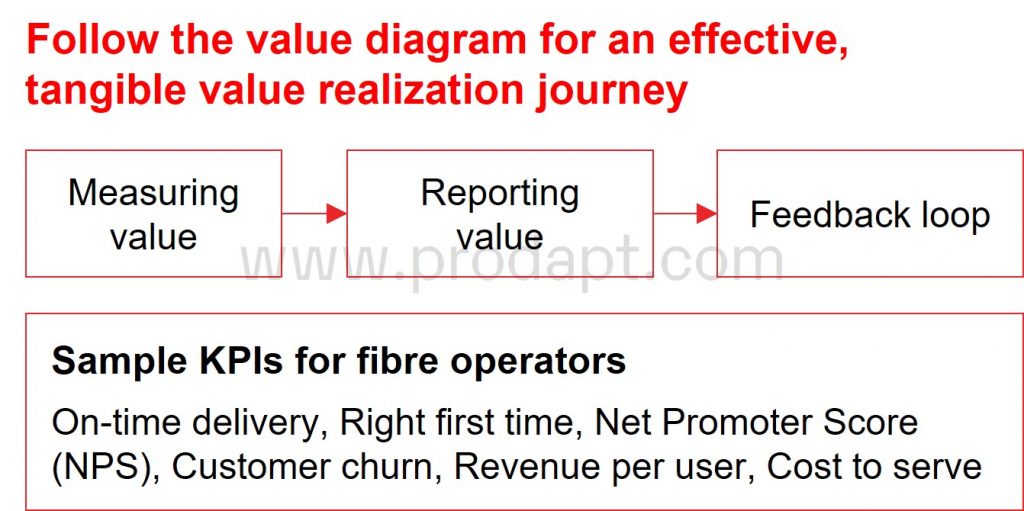This Industry Viewpoint was authored by Mandeep S Kwatra of Prodapt
As fiber operators fiercely compete for the top spot, they must constantly improve their operations while maintaining costs and ensuring seamless customer service. However, 60% of all corporate six sigma initiatives fail to deliver lasting results. We observed that many fiber operators still rely on traditional operations improvement activities performed on a one-time or on-demand basis translating to a short-term benefit only. Also, these activities must cope with the dynamic fiber environment.
As a result, fiber operators suffer from various challenges, like the inability to meet coverage targets on time, overshooting budgets, and delays in service delivery. Despite a lean operating model, they fail to sustain continuous improvement, resulting in poor customer experience, investment spikes, and unsustainable strategies.
It is imperative that fiber operators shift from a status quo to a continuous improvement culture. They must embed a Value-Driven Continuous Improvement (VDCI) function into their organization’s structure to instill a culture of constant advancement, reduce OpEx, and stay ahead of the competition.
Enable VDCI across your organization by following these four critical stages: Discovery, Formulation, Execution, Evaluation
- Discovery
Adopt a unified data-driven analysis approach below to identify gaps/opportunities across fiber functions and proactively address issues.
Identify and collect:
Gather data from multiple functions and understand the as-is fiber processes to build a use case repository, e.g., jeopardy management, technician dispatches, etc. Identify tracking parameters like KPIs/SLAs and benchmark the fiber process through detailed assessments.
Perform unified data-driven analysis:
- Process mining: Use tools like Celonis to discover gaps, monitor and improve processes, fiber journeys, system integration, etc.
- Predictive modeling using AI/ML: Use historical data to proactively predict and resolve issues (like network monitoring/failures)
- Business process analysis: Use tools like Aris, Signavio, and Oracle BPM to create, manage and analyze end-to-end business processes
Interpret:
- Identify improvement opportunities and potential issues, and address issues before they impact the customer
- Create baseline metrics to track progress
- Analyze the impact of operational gaps with Business Impact Analysis (BIA)
- Perform data validation with stakeholders
- Determine the ROI
- Formulation
Formulate change initiatives, prioritizing the opportunities/key areas and solution needs of fiber.
Prioritize identified opportunities:
- Use key lenses like strategic alignment, ROI, customer experience, regulatory
- Perform risk Assessment- Credit Risk, Data security, Operational risk
Identify and plan for the change initiatives:
- Check for the best solution- Conduct workshops and sit-by sessions with business owners and experts to give the best solution options. Consider key elements like investments, cost benefits, and implementation timelines to shortlist the solution
- Classify solutions into tactical IT, people and process, and strategic IT changes to ensure a holistic transformation. Further, create a RACI matrix for clear communication and smooth workflows across teams like the order desk, Technical Service Centre (TSC), Network Operations Centre (NOC), etc.

Figure 1: Solution categories
- Define the ‘To-Be’ process – Use tools like Aris, BPM, Visio, and Signavio to showcase the desired ‘To-Be’ process post-implementation
- Get signoffs from stakeholders
- Execution
Implement change initiatives to adopt fiberization goal changes rapidly.
- Prepare and empower your organization to embrace changes with proper change management and business readiness. Prioritize business readiness over solution implementation. Adoption of most change initiatives fail/get delayed/lose impact due to lack of business readiness
- Implement, document, and track change initiatives

Figure 2: Implementation of change initiatives
- Evaluation
Check the progress of change by continuously monitoring the solution and its expected benefits.
Monitor
- Extract data insights to compare pre- and post-implementation data
- Check if the desired changes are incorporated in the data
- Analyze KPIs and metrics to ensure that changes are moving in the correct direction
Value track
- Dedicate a team to track the benefits
- Allow the solution to stabilize
- Derive the actual numbers pertaining to realized benefits
- Link benefits to the operation and strategic value levers
- Conduct retrospective calls with the stakeholders to present the cost benefits/value leakage
- Create a feedback loop to assess the realized benefits and identify gaps for course correction and new opportunities to add to the backlog

Figure 3: Value diagram and sample KPIs
Recommendations
- Get the sign-on and sign-off for the desired vs. actual cost benefits from the business teams
- Use data querying tools (like SQL/Python scripts) for data extraction and analysis
- Create automated dashboards for periodic reporting and monitoring
- Define and follow the timeline for value-tracking. The recommended timelines are:
- Stabilization period: 1-2 weeks
- Periodic calculation of actual benefits: 2-3 months
- Retrospective calls with stakeholders: every 2 weeks
- Track actual benefits for 1 year
In conclusion:
Integrating the VDCI function into fiber operations can bring about a transformative culture of continuous improvement, resulting in a 15% reduction in operating costs, improved KPIs, and elevated customer experience.
I appreciate the efforts of my colleagues Jayanthi Kalyanasundaram, Sonal Suryavanshi, Viraj Rajan Vyawahare, and Deesha Chaware for their contributions and continuous support in compiling this article.
 Author Profile
Author Profile
Mandeep S Kwatra, Consulting Partner
Mandeep is a consulting partner at Prodapt, specializing in strategic advisory and transformations. He has over 30 years of experience in the Telecom, Media, and Consultancy domains; his focus has been on Business Process and Operations Transformation consulting & delivering programs. He is active in industry forums, publishing and speaking at events like TMForum, IEEE, CII, etc. He also has a patent on “Method and System for Implementing a Collaborative Customer Service Model” to his name.
Prodapt’s customers range from telecom operators, digital/multi-service providers (D/MSPs), technology, and digital platform companies in Connectedness. Prodapt builds, integrates, and operates solutions enabling next-generation technologies and innovations. Prodapt services global leaders, including Google, Facebook, Amazon, Microsoft, AT&T, Verizon, CenturyLink, Adtran, Vodafone, Liberty Global, Windstream, Virgin Media, Rogers, and Deutsche Telekom, among many others. Prodapt’s customers help more than a billion people and five billion devices stay connected.
If you haven't already, please take our Reader Survey! Just 3 questions to help us better understand who is reading Telecom Ramblings so we can serve you better!
Categories: Artificial Intelligence · Industry Viewpoint · SDN





Discuss this Post